Memorandum of Legal Advice: Contractual Obligations and Disputes
VerifiedAdded on 2023/01/19
|6
|2289
|70
Report
AI Summary
This memorandum provides legal advice to John regarding several contract law issues. It analyzes whether valid contracts were formed with Contractors A, B, and C, examining offer and acceptance, the postal rule, and promissory estoppel. The analysis considers whether John is obligated to pay Contractor C an additional AUD 40,000 and if he can claim a AUD 600 reward for returning a wallet. The memorandum differentiates between an offer and an invitation to treat, examines the implications of counteroffers, and applies the postal rule to determine the validity of acceptances. It also discusses promissory estoppel and its application in contract disputes. The memorandum concludes that a valid contract exists between John and Contractor B, but not with Contractor A, and John is not bound to pay the additional amount to Contractor C. Furthermore, John is entitled to the reward for returning the wallet.
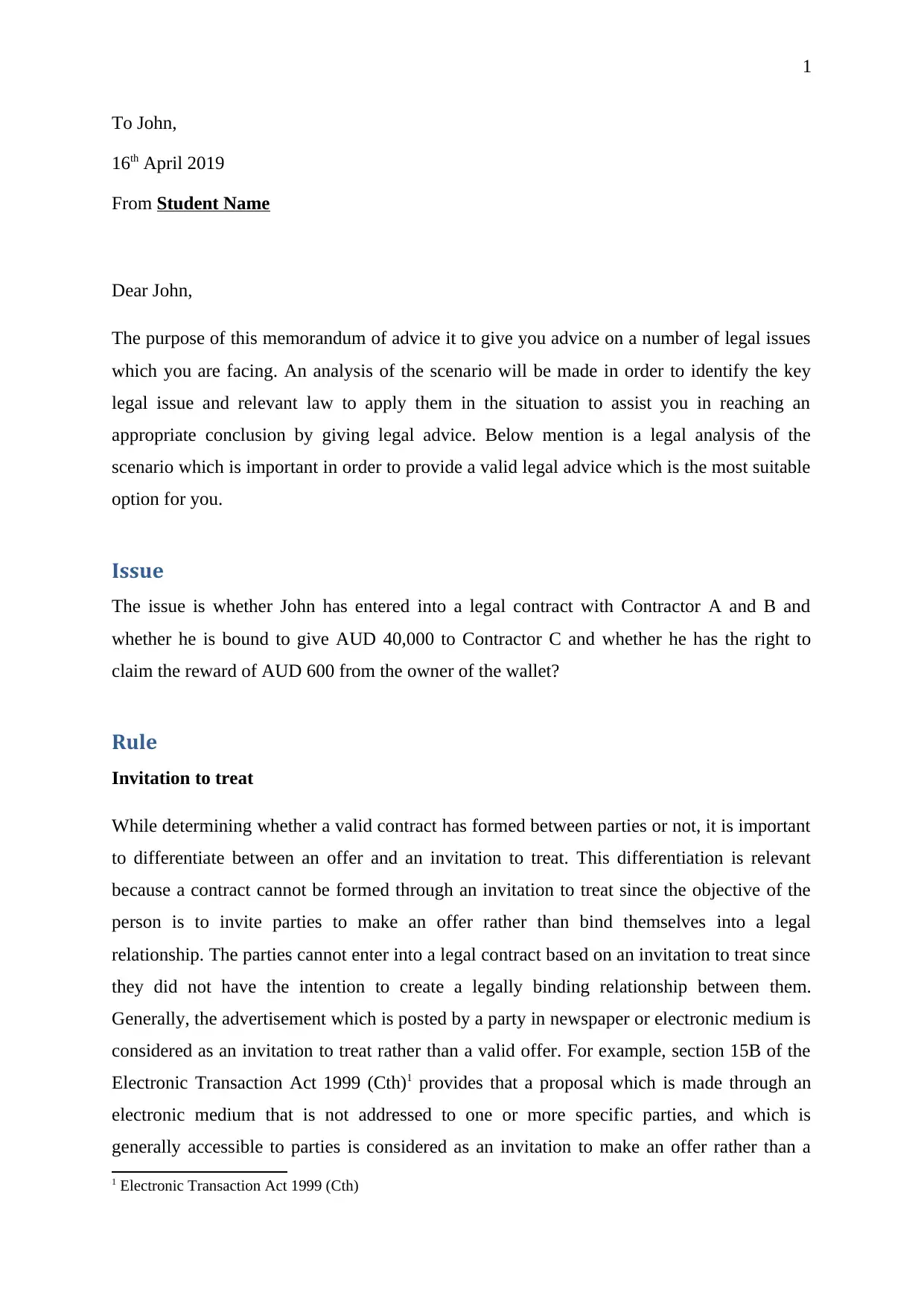
1
To John,
16th April 2019
From Student Name
Dear John,
The purpose of this memorandum of advice it to give you advice on a number of legal issues
which you are facing. An analysis of the scenario will be made in order to identify the key
legal issue and relevant law to apply them in the situation to assist you in reaching an
appropriate conclusion by giving legal advice. Below mention is a legal analysis of the
scenario which is important in order to provide a valid legal advice which is the most suitable
option for you.
Issue
The issue is whether John has entered into a legal contract with Contractor A and B and
whether he is bound to give AUD 40,000 to Contractor C and whether he has the right to
claim the reward of AUD 600 from the owner of the wallet?
Rule
Invitation to treat
While determining whether a valid contract has formed between parties or not, it is important
to differentiate between an offer and an invitation to treat. This differentiation is relevant
because a contract cannot be formed through an invitation to treat since the objective of the
person is to invite parties to make an offer rather than bind themselves into a legal
relationship. The parties cannot enter into a legal contract based on an invitation to treat since
they did not have the intention to create a legally binding relationship between them.
Generally, the advertisement which is posted by a party in newspaper or electronic medium is
considered as an invitation to treat rather than a valid offer. For example, section 15B of the
Electronic Transaction Act 1999 (Cth)1 provides that a proposal which is made through an
electronic medium that is not addressed to one or more specific parties, and which is
generally accessible to parties is considered as an invitation to make an offer rather than a
1 Electronic Transaction Act 1999 (Cth)
To John,
16th April 2019
From Student Name
Dear John,
The purpose of this memorandum of advice it to give you advice on a number of legal issues
which you are facing. An analysis of the scenario will be made in order to identify the key
legal issue and relevant law to apply them in the situation to assist you in reaching an
appropriate conclusion by giving legal advice. Below mention is a legal analysis of the
scenario which is important in order to provide a valid legal advice which is the most suitable
option for you.
Issue
The issue is whether John has entered into a legal contract with Contractor A and B and
whether he is bound to give AUD 40,000 to Contractor C and whether he has the right to
claim the reward of AUD 600 from the owner of the wallet?
Rule
Invitation to treat
While determining whether a valid contract has formed between parties or not, it is important
to differentiate between an offer and an invitation to treat. This differentiation is relevant
because a contract cannot be formed through an invitation to treat since the objective of the
person is to invite parties to make an offer rather than bind themselves into a legal
relationship. The parties cannot enter into a legal contract based on an invitation to treat since
they did not have the intention to create a legally binding relationship between them.
Generally, the advertisement which is posted by a party in newspaper or electronic medium is
considered as an invitation to treat rather than a valid offer. For example, section 15B of the
Electronic Transaction Act 1999 (Cth)1 provides that a proposal which is made through an
electronic medium that is not addressed to one or more specific parties, and which is
generally accessible to parties is considered as an invitation to make an offer rather than a
1 Electronic Transaction Act 1999 (Cth)
Paraphrase This Document
Need a fresh take? Get an instant paraphrase of this document with our AI Paraphraser
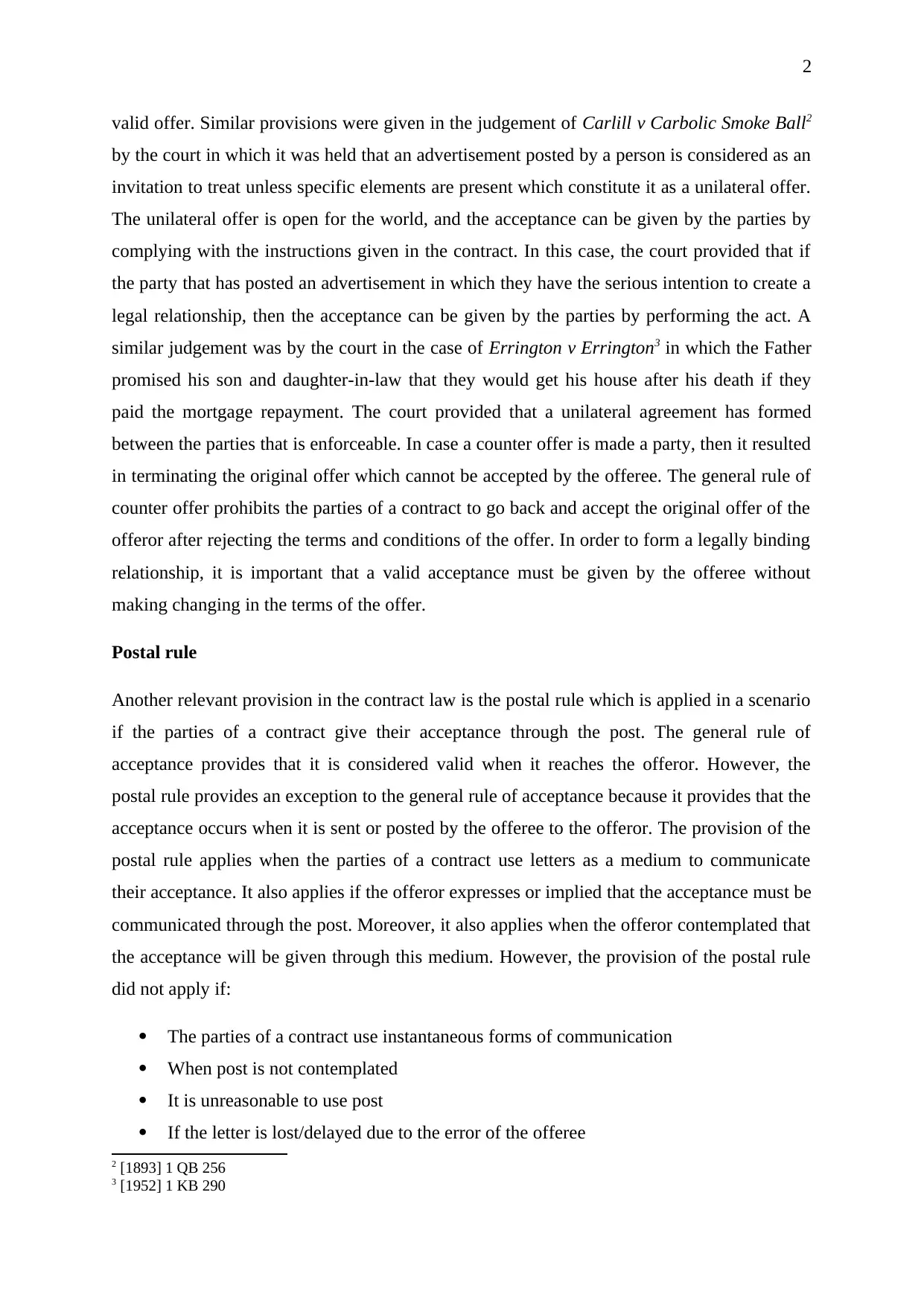
2
valid offer. Similar provisions were given in the judgement of Carlill v Carbolic Smoke Ball2
by the court in which it was held that an advertisement posted by a person is considered as an
invitation to treat unless specific elements are present which constitute it as a unilateral offer.
The unilateral offer is open for the world, and the acceptance can be given by the parties by
complying with the instructions given in the contract. In this case, the court provided that if
the party that has posted an advertisement in which they have the serious intention to create a
legal relationship, then the acceptance can be given by the parties by performing the act. A
similar judgement was by the court in the case of Errington v Errington3 in which the Father
promised his son and daughter-in-law that they would get his house after his death if they
paid the mortgage repayment. The court provided that a unilateral agreement has formed
between the parties that is enforceable. In case a counter offer is made a party, then it resulted
in terminating the original offer which cannot be accepted by the offeree. The general rule of
counter offer prohibits the parties of a contract to go back and accept the original offer of the
offeror after rejecting the terms and conditions of the offer. In order to form a legally binding
relationship, it is important that a valid acceptance must be given by the offeree without
making changing in the terms of the offer.
Postal rule
Another relevant provision in the contract law is the postal rule which is applied in a scenario
if the parties of a contract give their acceptance through the post. The general rule of
acceptance provides that it is considered valid when it reaches the offeror. However, the
postal rule provides an exception to the general rule of acceptance because it provides that the
acceptance occurs when it is sent or posted by the offeree to the offeror. The provision of the
postal rule applies when the parties of a contract use letters as a medium to communicate
their acceptance. It also applies if the offeror expresses or implied that the acceptance must be
communicated through the post. Moreover, it also applies when the offeror contemplated that
the acceptance will be given through this medium. However, the provision of the postal rule
did not apply if:
The parties of a contract use instantaneous forms of communication
When post is not contemplated
It is unreasonable to use post
If the letter is lost/delayed due to the error of the offeree
2 [1893] 1 QB 256
3 [1952] 1 KB 290
valid offer. Similar provisions were given in the judgement of Carlill v Carbolic Smoke Ball2
by the court in which it was held that an advertisement posted by a person is considered as an
invitation to treat unless specific elements are present which constitute it as a unilateral offer.
The unilateral offer is open for the world, and the acceptance can be given by the parties by
complying with the instructions given in the contract. In this case, the court provided that if
the party that has posted an advertisement in which they have the serious intention to create a
legal relationship, then the acceptance can be given by the parties by performing the act. A
similar judgement was by the court in the case of Errington v Errington3 in which the Father
promised his son and daughter-in-law that they would get his house after his death if they
paid the mortgage repayment. The court provided that a unilateral agreement has formed
between the parties that is enforceable. In case a counter offer is made a party, then it resulted
in terminating the original offer which cannot be accepted by the offeree. The general rule of
counter offer prohibits the parties of a contract to go back and accept the original offer of the
offeror after rejecting the terms and conditions of the offer. In order to form a legally binding
relationship, it is important that a valid acceptance must be given by the offeree without
making changing in the terms of the offer.
Postal rule
Another relevant provision in the contract law is the postal rule which is applied in a scenario
if the parties of a contract give their acceptance through the post. The general rule of
acceptance provides that it is considered valid when it reaches the offeror. However, the
postal rule provides an exception to the general rule of acceptance because it provides that the
acceptance occurs when it is sent or posted by the offeree to the offeror. The provision of the
postal rule applies when the parties of a contract use letters as a medium to communicate
their acceptance. It also applies if the offeror expresses or implied that the acceptance must be
communicated through the post. Moreover, it also applies when the offeror contemplated that
the acceptance will be given through this medium. However, the provision of the postal rule
did not apply if:
The parties of a contract use instantaneous forms of communication
When post is not contemplated
It is unreasonable to use post
If the letter is lost/delayed due to the error of the offeree
2 [1893] 1 QB 256
3 [1952] 1 KB 290
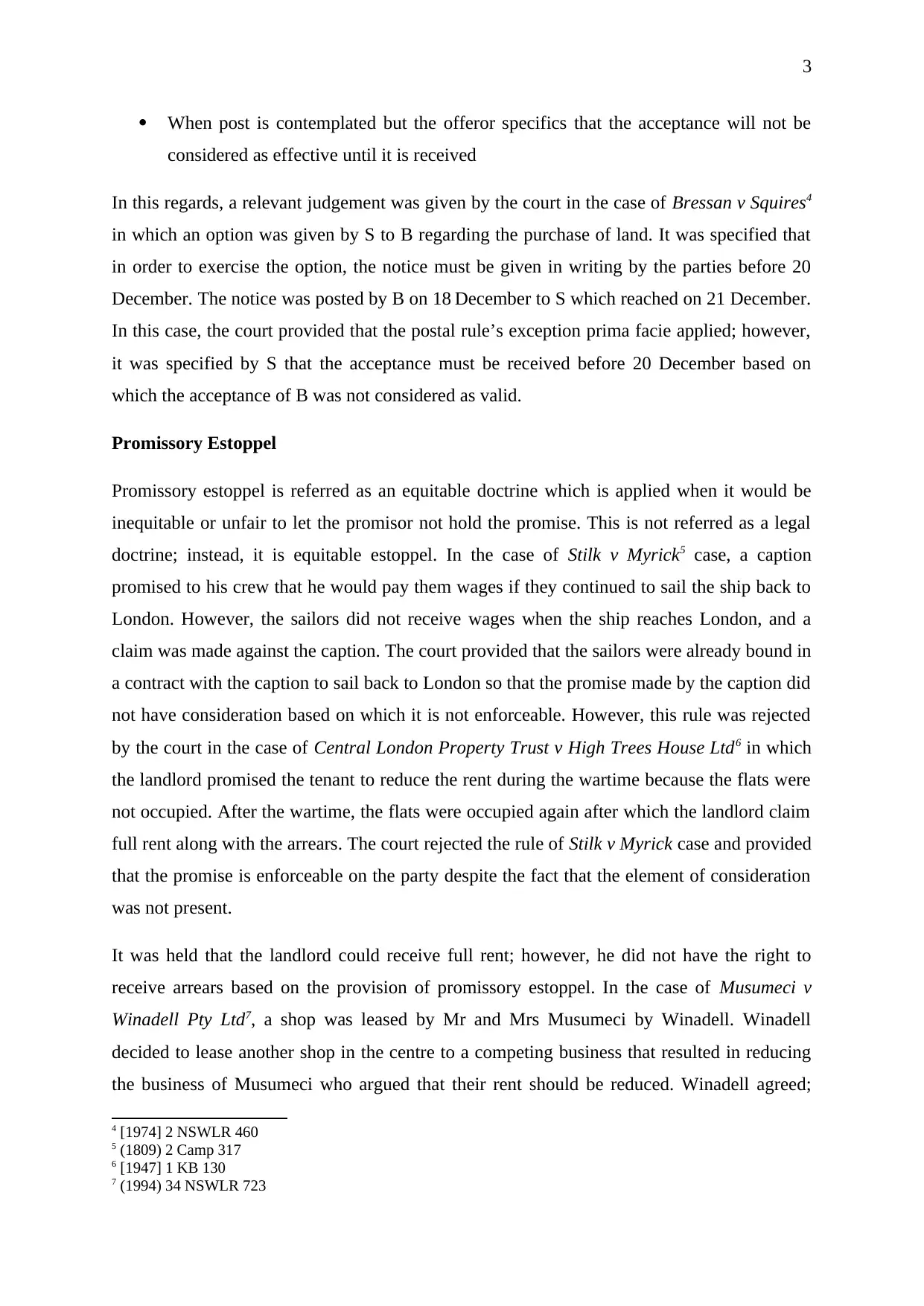
3
When post is contemplated but the offeror specifics that the acceptance will not be
considered as effective until it is received
In this regards, a relevant judgement was given by the court in the case of Bressan v Squires4
in which an option was given by S to B regarding the purchase of land. It was specified that
in order to exercise the option, the notice must be given in writing by the parties before 20
December. The notice was posted by B on 18 December to S which reached on 21 December.
In this case, the court provided that the postal rule’s exception prima facie applied; however,
it was specified by S that the acceptance must be received before 20 December based on
which the acceptance of B was not considered as valid.
Promissory Estoppel
Promissory estoppel is referred as an equitable doctrine which is applied when it would be
inequitable or unfair to let the promisor not hold the promise. This is not referred as a legal
doctrine; instead, it is equitable estoppel. In the case of Stilk v Myrick5 case, a caption
promised to his crew that he would pay them wages if they continued to sail the ship back to
London. However, the sailors did not receive wages when the ship reaches London, and a
claim was made against the caption. The court provided that the sailors were already bound in
a contract with the caption to sail back to London so that the promise made by the caption did
not have consideration based on which it is not enforceable. However, this rule was rejected
by the court in the case of Central London Property Trust v High Trees House Ltd6 in which
the landlord promised the tenant to reduce the rent during the wartime because the flats were
not occupied. After the wartime, the flats were occupied again after which the landlord claim
full rent along with the arrears. The court rejected the rule of Stilk v Myrick case and provided
that the promise is enforceable on the party despite the fact that the element of consideration
was not present.
It was held that the landlord could receive full rent; however, he did not have the right to
receive arrears based on the provision of promissory estoppel. In the case of Musumeci v
Winadell Pty Ltd7, a shop was leased by Mr and Mrs Musumeci by Winadell. Winadell
decided to lease another shop in the centre to a competing business that resulted in reducing
the business of Musumeci who argued that their rent should be reduced. Winadell agreed;
4 [1974] 2 NSWLR 460
5 (1809) 2 Camp 317
6 [1947] 1 KB 130
7 (1994) 34 NSWLR 723
When post is contemplated but the offeror specifics that the acceptance will not be
considered as effective until it is received
In this regards, a relevant judgement was given by the court in the case of Bressan v Squires4
in which an option was given by S to B regarding the purchase of land. It was specified that
in order to exercise the option, the notice must be given in writing by the parties before 20
December. The notice was posted by B on 18 December to S which reached on 21 December.
In this case, the court provided that the postal rule’s exception prima facie applied; however,
it was specified by S that the acceptance must be received before 20 December based on
which the acceptance of B was not considered as valid.
Promissory Estoppel
Promissory estoppel is referred as an equitable doctrine which is applied when it would be
inequitable or unfair to let the promisor not hold the promise. This is not referred as a legal
doctrine; instead, it is equitable estoppel. In the case of Stilk v Myrick5 case, a caption
promised to his crew that he would pay them wages if they continued to sail the ship back to
London. However, the sailors did not receive wages when the ship reaches London, and a
claim was made against the caption. The court provided that the sailors were already bound in
a contract with the caption to sail back to London so that the promise made by the caption did
not have consideration based on which it is not enforceable. However, this rule was rejected
by the court in the case of Central London Property Trust v High Trees House Ltd6 in which
the landlord promised the tenant to reduce the rent during the wartime because the flats were
not occupied. After the wartime, the flats were occupied again after which the landlord claim
full rent along with the arrears. The court rejected the rule of Stilk v Myrick case and provided
that the promise is enforceable on the party despite the fact that the element of consideration
was not present.
It was held that the landlord could receive full rent; however, he did not have the right to
receive arrears based on the provision of promissory estoppel. In the case of Musumeci v
Winadell Pty Ltd7, a shop was leased by Mr and Mrs Musumeci by Winadell. Winadell
decided to lease another shop in the centre to a competing business that resulted in reducing
the business of Musumeci who argued that their rent should be reduced. Winadell agreed;
4 [1974] 2 NSWLR 460
5 (1809) 2 Camp 317
6 [1947] 1 KB 130
7 (1994) 34 NSWLR 723
⊘ This is a preview!⊘
Do you want full access?
Subscribe today to unlock all pages.

Trusted by 1+ million students worldwide
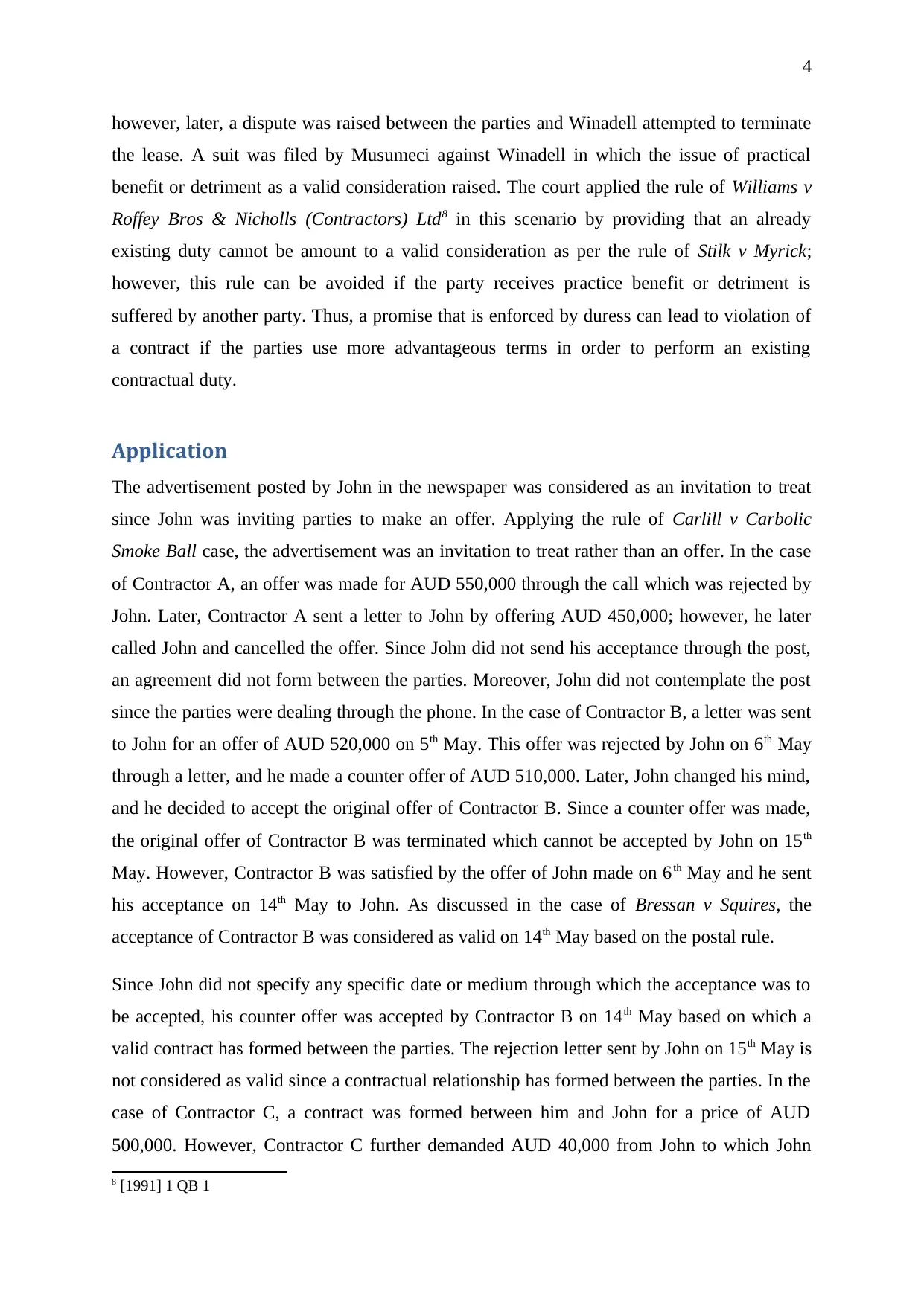
4
however, later, a dispute was raised between the parties and Winadell attempted to terminate
the lease. A suit was filed by Musumeci against Winadell in which the issue of practical
benefit or detriment as a valid consideration raised. The court applied the rule of Williams v
Roffey Bros & Nicholls (Contractors) Ltd8 in this scenario by providing that an already
existing duty cannot be amount to a valid consideration as per the rule of Stilk v Myrick;
however, this rule can be avoided if the party receives practice benefit or detriment is
suffered by another party. Thus, a promise that is enforced by duress can lead to violation of
a contract if the parties use more advantageous terms in order to perform an existing
contractual duty.
Application
The advertisement posted by John in the newspaper was considered as an invitation to treat
since John was inviting parties to make an offer. Applying the rule of Carlill v Carbolic
Smoke Ball case, the advertisement was an invitation to treat rather than an offer. In the case
of Contractor A, an offer was made for AUD 550,000 through the call which was rejected by
John. Later, Contractor A sent a letter to John by offering AUD 450,000; however, he later
called John and cancelled the offer. Since John did not send his acceptance through the post,
an agreement did not form between the parties. Moreover, John did not contemplate the post
since the parties were dealing through the phone. In the case of Contractor B, a letter was sent
to John for an offer of AUD 520,000 on 5th May. This offer was rejected by John on 6th May
through a letter, and he made a counter offer of AUD 510,000. Later, John changed his mind,
and he decided to accept the original offer of Contractor B. Since a counter offer was made,
the original offer of Contractor B was terminated which cannot be accepted by John on 15th
May. However, Contractor B was satisfied by the offer of John made on 6th May and he sent
his acceptance on 14th May to John. As discussed in the case of Bressan v Squires, the
acceptance of Contractor B was considered as valid on 14th May based on the postal rule.
Since John did not specify any specific date or medium through which the acceptance was to
be accepted, his counter offer was accepted by Contractor B on 14th May based on which a
valid contract has formed between the parties. The rejection letter sent by John on 15th May is
not considered as valid since a contractual relationship has formed between the parties. In the
case of Contractor C, a contract was formed between him and John for a price of AUD
500,000. However, Contractor C further demanded AUD 40,000 from John to which John
8 [1991] 1 QB 1
however, later, a dispute was raised between the parties and Winadell attempted to terminate
the lease. A suit was filed by Musumeci against Winadell in which the issue of practical
benefit or detriment as a valid consideration raised. The court applied the rule of Williams v
Roffey Bros & Nicholls (Contractors) Ltd8 in this scenario by providing that an already
existing duty cannot be amount to a valid consideration as per the rule of Stilk v Myrick;
however, this rule can be avoided if the party receives practice benefit or detriment is
suffered by another party. Thus, a promise that is enforced by duress can lead to violation of
a contract if the parties use more advantageous terms in order to perform an existing
contractual duty.
Application
The advertisement posted by John in the newspaper was considered as an invitation to treat
since John was inviting parties to make an offer. Applying the rule of Carlill v Carbolic
Smoke Ball case, the advertisement was an invitation to treat rather than an offer. In the case
of Contractor A, an offer was made for AUD 550,000 through the call which was rejected by
John. Later, Contractor A sent a letter to John by offering AUD 450,000; however, he later
called John and cancelled the offer. Since John did not send his acceptance through the post,
an agreement did not form between the parties. Moreover, John did not contemplate the post
since the parties were dealing through the phone. In the case of Contractor B, a letter was sent
to John for an offer of AUD 520,000 on 5th May. This offer was rejected by John on 6th May
through a letter, and he made a counter offer of AUD 510,000. Later, John changed his mind,
and he decided to accept the original offer of Contractor B. Since a counter offer was made,
the original offer of Contractor B was terminated which cannot be accepted by John on 15th
May. However, Contractor B was satisfied by the offer of John made on 6th May and he sent
his acceptance on 14th May to John. As discussed in the case of Bressan v Squires, the
acceptance of Contractor B was considered as valid on 14th May based on the postal rule.
Since John did not specify any specific date or medium through which the acceptance was to
be accepted, his counter offer was accepted by Contractor B on 14th May based on which a
valid contract has formed between the parties. The rejection letter sent by John on 15th May is
not considered as valid since a contractual relationship has formed between the parties. In the
case of Contractor C, a contract was formed between him and John for a price of AUD
500,000. However, Contractor C further demanded AUD 40,000 from John to which John
8 [1991] 1 QB 1
Paraphrase This Document
Need a fresh take? Get an instant paraphrase of this document with our AI Paraphraser
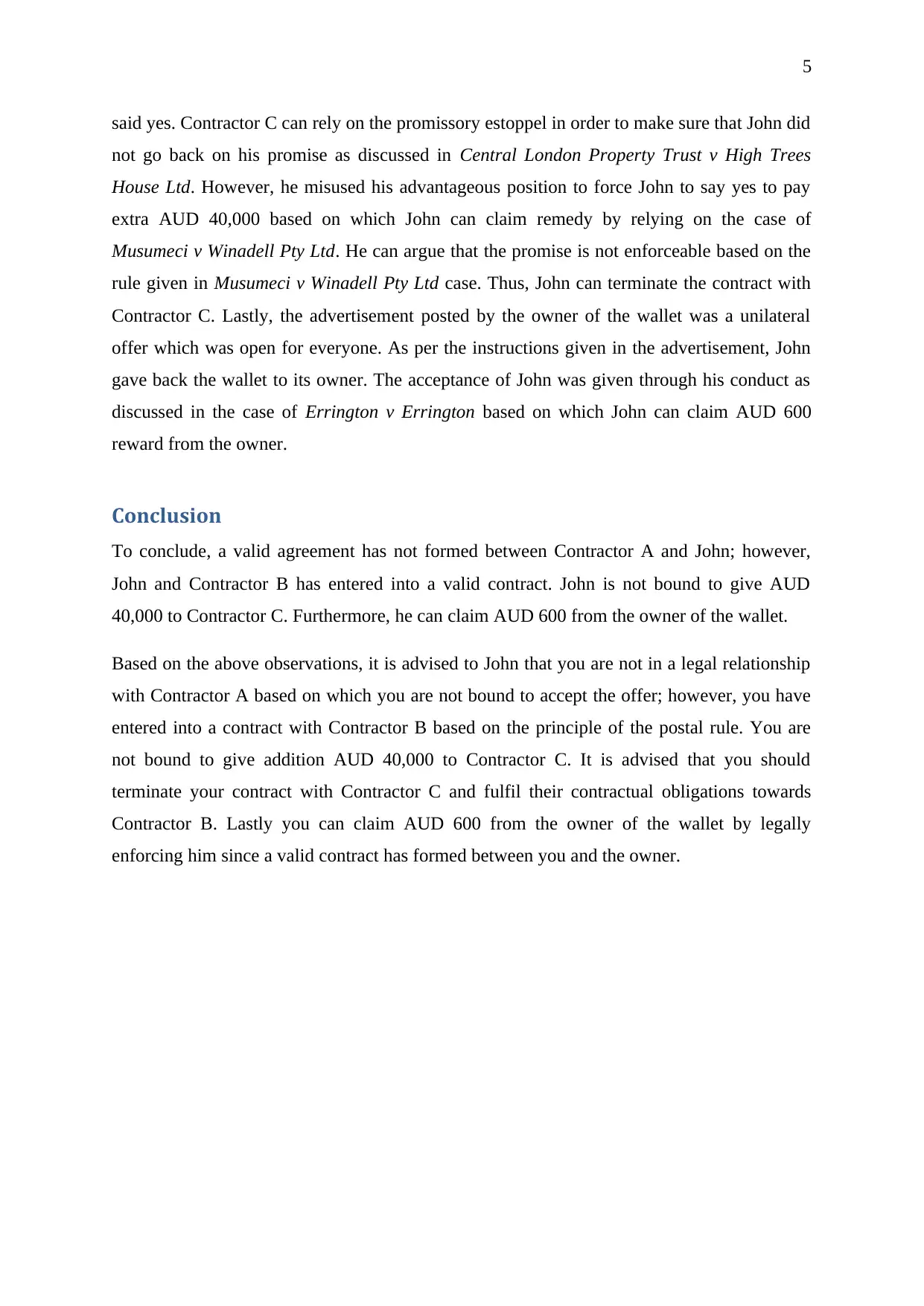
5
said yes. Contractor C can rely on the promissory estoppel in order to make sure that John did
not go back on his promise as discussed in Central London Property Trust v High Trees
House Ltd. However, he misused his advantageous position to force John to say yes to pay
extra AUD 40,000 based on which John can claim remedy by relying on the case of
Musumeci v Winadell Pty Ltd. He can argue that the promise is not enforceable based on the
rule given in Musumeci v Winadell Pty Ltd case. Thus, John can terminate the contract with
Contractor C. Lastly, the advertisement posted by the owner of the wallet was a unilateral
offer which was open for everyone. As per the instructions given in the advertisement, John
gave back the wallet to its owner. The acceptance of John was given through his conduct as
discussed in the case of Errington v Errington based on which John can claim AUD 600
reward from the owner.
Conclusion
To conclude, a valid agreement has not formed between Contractor A and John; however,
John and Contractor B has entered into a valid contract. John is not bound to give AUD
40,000 to Contractor C. Furthermore, he can claim AUD 600 from the owner of the wallet.
Based on the above observations, it is advised to John that you are not in a legal relationship
with Contractor A based on which you are not bound to accept the offer; however, you have
entered into a contract with Contractor B based on the principle of the postal rule. You are
not bound to give addition AUD 40,000 to Contractor C. It is advised that you should
terminate your contract with Contractor C and fulfil their contractual obligations towards
Contractor B. Lastly you can claim AUD 600 from the owner of the wallet by legally
enforcing him since a valid contract has formed between you and the owner.
said yes. Contractor C can rely on the promissory estoppel in order to make sure that John did
not go back on his promise as discussed in Central London Property Trust v High Trees
House Ltd. However, he misused his advantageous position to force John to say yes to pay
extra AUD 40,000 based on which John can claim remedy by relying on the case of
Musumeci v Winadell Pty Ltd. He can argue that the promise is not enforceable based on the
rule given in Musumeci v Winadell Pty Ltd case. Thus, John can terminate the contract with
Contractor C. Lastly, the advertisement posted by the owner of the wallet was a unilateral
offer which was open for everyone. As per the instructions given in the advertisement, John
gave back the wallet to its owner. The acceptance of John was given through his conduct as
discussed in the case of Errington v Errington based on which John can claim AUD 600
reward from the owner.
Conclusion
To conclude, a valid agreement has not formed between Contractor A and John; however,
John and Contractor B has entered into a valid contract. John is not bound to give AUD
40,000 to Contractor C. Furthermore, he can claim AUD 600 from the owner of the wallet.
Based on the above observations, it is advised to John that you are not in a legal relationship
with Contractor A based on which you are not bound to accept the offer; however, you have
entered into a contract with Contractor B based on the principle of the postal rule. You are
not bound to give addition AUD 40,000 to Contractor C. It is advised that you should
terminate your contract with Contractor C and fulfil their contractual obligations towards
Contractor B. Lastly you can claim AUD 600 from the owner of the wallet by legally
enforcing him since a valid contract has formed between you and the owner.
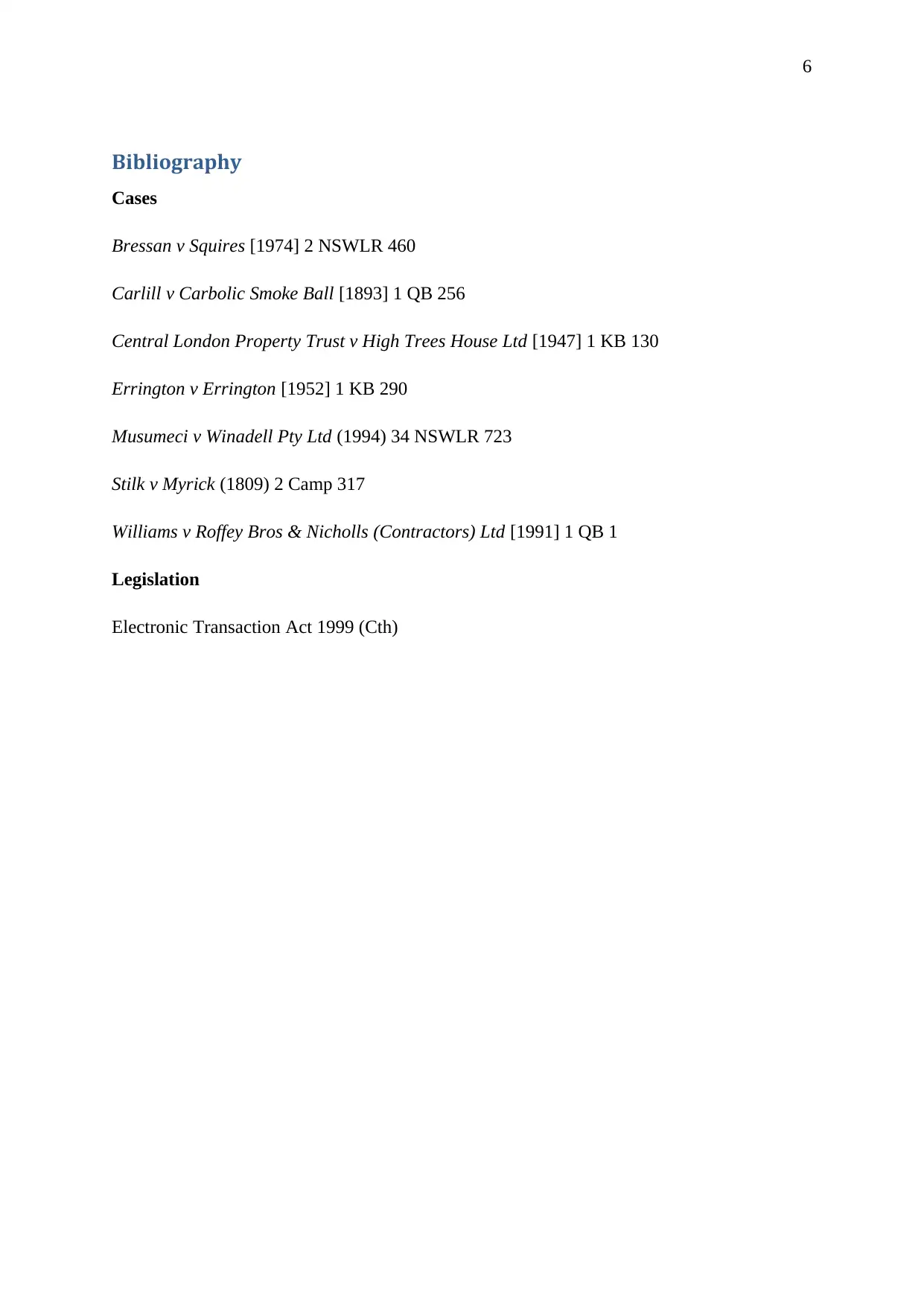
6
Bibliography
Cases
Bressan v Squires [1974] 2 NSWLR 460
Carlill v Carbolic Smoke Ball [1893] 1 QB 256
Central London Property Trust v High Trees House Ltd [1947] 1 KB 130
Errington v Errington [1952] 1 KB 290
Musumeci v Winadell Pty Ltd (1994) 34 NSWLR 723
Stilk v Myrick (1809) 2 Camp 317
Williams v Roffey Bros & Nicholls (Contractors) Ltd [1991] 1 QB 1
Legislation
Electronic Transaction Act 1999 (Cth)
Bibliography
Cases
Bressan v Squires [1974] 2 NSWLR 460
Carlill v Carbolic Smoke Ball [1893] 1 QB 256
Central London Property Trust v High Trees House Ltd [1947] 1 KB 130
Errington v Errington [1952] 1 KB 290
Musumeci v Winadell Pty Ltd (1994) 34 NSWLR 723
Stilk v Myrick (1809) 2 Camp 317
Williams v Roffey Bros & Nicholls (Contractors) Ltd [1991] 1 QB 1
Legislation
Electronic Transaction Act 1999 (Cth)
⊘ This is a preview!⊘
Do you want full access?
Subscribe today to unlock all pages.

Trusted by 1+ million students worldwide
1 out of 6
Related Documents
Your All-in-One AI-Powered Toolkit for Academic Success.
+13062052269
info@desklib.com
Available 24*7 on WhatsApp / Email
![[object Object]](/_next/static/media/star-bottom.7253800d.svg)
Unlock your academic potential
Copyright © 2020–2025 A2Z Services. All Rights Reserved. Developed and managed by ZUCOL.





